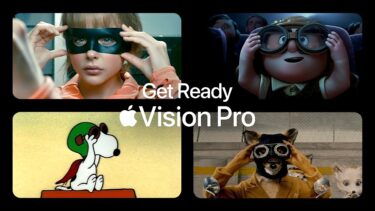Apple's marketing aside, Vision Pro is still a VR headset

Apple wants to give the headset narrative a new spin with developer guidelines and a new ad. But the Vision Pro is still a VR headset.
Yesterday, Apple announced the US launch date for the Vision Pro. On the same day, the company released a new ad for the headset called "Get ready".
It shows protagonists from iconic movies and TV shows putting on masks, helmets and futuristic glasses. You can see clips from Star Wars, Iron Man and Back to the Future, among others. At the end, you can see a woman putting on Vision Pro.
With this ad, Apple is trying to normalize the tech-infused glasses and headsets and give Vision Pro a sci-fi twist.
Interestingly, all the examples shown allow the character to see through them. Apple avoids the association with virtual reality, which replaces reality and thus can have a dystopian component. Instead, the technology is meant to enhance natural vision, which could explain the product's name.
Apple's nomenclature: Spatial computing instead of VR/AR/MR
Meanwhile, Apple's developer guidelines for describing Vision Pro apps in the App Store caught the attention of the VR/AR community on Twitter. In one bullet point, Apple writes:
"Spatial computing: Refer to your app as a spatial computing app. Don’t describe your app experience as augmented reality (AR), virtual reality (VR), extended reality (XR), or mixed reality (MR)."
Apple also writes that Vision pro should not be referred to generically as a "headset". And in yesterday's press release, Apple calls VR/AR games "spatial games" instead.
The company distances itself from common terms such as "virtual reality", "headset", and "metaverse" and instead refers to spatial computing and spatial computers, suggesting that Vision Pro is something entirely new and that Apple invented the technology, which isn't the case.
Vision Pro is a (very sophisticated) VR headset
Apple wants Vision Pro to look like a pair of sci-fi glasses that are transparent in both directions. Apple's impressive EyeSight technology, which displays the user's eyes on an external display, adds to this impression and is unprecedented in a product of this kind.
But technically, Vision Pro is still a VR headset. It has the same form factor as devices in this category and uses the same display technology as VR headsets before Vision Pro. In addition to pure VR headsets, it creates a digital replica of the user's environment using cameras and sophisticated algorithms, but ultimately, you're still looking at a pair of opaque displays. This type of technology, usually referred to as passthrough, isn't new and is available on other devices like the Quest 3, albeit at a much lower quality.
The see-through aspect is artificial and digital in both directions, unlike other, much more limited optical AR headsets like Magic Leap and Hololens. So Apple Vision Pro doesn't do anything completely different than previous VR headsets, it just does it much better. Apple's advertising and nomenclature can't change that.
Note: Links to online stores in articles can be so-called affiliate links. If you buy through this link, MIXED receives a commission from the provider. For you the price does not change.